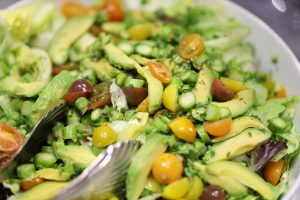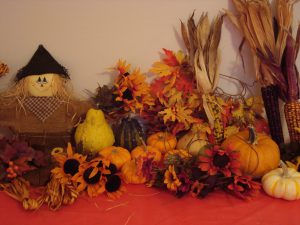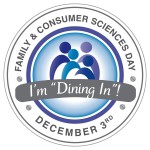
by Suzanne Holloway | Nov 15, 2024
Thanksgiving, like other holidays, promises gratitude and togetherness, but it can also bring stress, awkward moments, and even indigestion. As family members gather – from near and far – to share a meal, navigating conflicting personalities, differing opinion, and the drive for perfection can make hosting feel daunting. To help ensure a peaceful (and maybe even enjoyable) holiday, here are a few Thanksgiving dos and don’ts.
DOs
- Set Realistic Expectations. While many dream of a picture-perfect Thanksgiving, real life is rarely like a cheesy holiday movie. Accept that things might not go as planned, and those imperfections are perfectly fine. Instead of pursuing perfection, aim for a day where everyone has moments of enjoyment, even if brief.
- Plan Ahead. Hosting Thanksgiving can be overwhelming—you’re the cook, cleaner, and event planner all in one. Schedule tasks into manageable chunks over the course of a few days, prepping dishes in advance, and delegating responsibilities. Ask your guests to bring sides – this lightens your load and involves them in the holiday prep.
- Choose Your Seat Wisely. Sit near family members you get along with. If you’re arranging seating, separate personalities likely to clash to keep the atmosphere peaceful.
- Take Care of Yourself. Schedule time for yourself before, during, and after Thanksgiving. It can be a short walk, meditating, or a quick and quiet escape to play a video game or watch a movie. If you are unable to leave a stressful situation, calm yourself with five slow, deep breaths.
- Learn to Let Things Go. Family quirks and annoyances are part of the package. Practice patience and remember, it’s just for a short time.
- Remember the Reason for the Season. Reflect on or share what you are thankful for—whether it’s a good meal, health, a roof over your head, or time with loved ones. Focusing on gratitude can be a great tool to shift the mood toward positivity.
DON’Ts
- Dominate the Conversation. Thanksgiving is for catching up with friends and family, not just talking about yourself. Be mindful, and make space for others to share, especially if it’s been a while since you have seen them.
- Try to Fix Problems. Now is not the time for unsolicited advice or life coaching. One conversation over what is supposed to be a happy meal won’t mend a marriage, convince someone to start a family, make someone a better parent, or get them to hit the gym.
- Discuss Sensitive Topics. Subjects like politics, religion, or lifestyle choices are best left off the dinner table. Even well-meaning questions like “When are you getting married?” or “When can I expect grandchildren?” may seem innocent but can make people uncomfortable. Stick to lighter topics that bring people together, such as favorite family traditions, upcoming plans, or funny memories from past Thanksgivings, this helps create a positive, welcoming environment for everyone.
- Drink Excessively. Some people become argumentative or aggressive when drinking, which can escalate tensions. Avoid these individuals if they get rowdy, and prevent them from driving. If this is an issue for you, consider mocktails or non-alcoholic drinks.
Thanksgiving does not have to be a stressful situation. By prioritizing your well-being and keeping gratitude at the forefront of the celebration, you can make Thanksgiving a meaningful, enjoyable day—flaws and all.
Additional Sources

by Melanie Taylor | Nov 24, 2020
2020 has been a year of many changes and challenges due to the Coronavirus pandemic, which unfortunately will continue into our holiday season. To protect our friends, family and community members we must continue following the science-based guidelines provided by the Centers for Disease Control and Prevention (CDC) and your state and local guidelines to prevent exposure and the spread of the virus.
Unfortunately, the Covid-19 epidemic numbers are rising again. Gatherings of any kind, both small and large, are contributing to the rise in positive cases. We can all make choices based on the scientific research that can protect us and others by making small changes in our 2020 holiday celebrations. Limiting the risk and being diligent in our actions should be our main goal until a vaccine is approved and dispersed throughout the country.

Holiday Dinner
Photo Source: UF/IFAS
Some unique and easy ways to celebrate the holidays this year are to “gather virtually” with those not in your immediate household or to gather in-person only with members of your own household. These two types of gatherings offer the lowest risk for spreading the virus. Your household is anyone who currently lives and shares common spaces in your home. People who do not currently live in your home, such as college students who are returning home from school for the holidays, should be considered part of different households. In-person gatherings that bring together family members or friends from different households, including those college students returning home, offer varying levels of risk. The level of risk is difficult to determine because people may have been exposed and/or are a carrier and may not be aware of it.
Here are some specific things to consider when deciding how to celebrate your holidays.
- Number of cases in your community – Be sure to know the number of positive Covid cases in your community. If the numbers are rising or are already high you should take precautions based on the data. You can check your specific county or city Covid rates at your local health departments website.
- Exposure during travel – Airports, bus stations, train stations, public transport, gas stations, rest stops and hotels are all places travelers can be exposed to the virus in the air and on surfaces. Be aware if you will be traveling or if you have guests traveling to your home.
- Location of your gathering – Indoor gatherings, especially those with poor ventilation, expose your family to more risk than outdoor gatherings.
- How long will your gathering last? – Time is an important factor to consider. The longer the gathering lasts the more risk those attendees will have of being exposed. Being within 6 feet of someone who has Covid for a cumulative total of 15 minutes or more greatly increases the risk of becoming sick and requires a 14-day quarantine.
- Number and crowding of people at the gathering – Gatherings with more people bring more risk than gatherings with fewer people. The size of a holiday gathering should be determined based on the ability of attendees from different households to stay 6 feet (2 arm lengths) apart, wear masks, wash hands and follow state, local, territorial, or tribal health and safety laws, rules and regulations.
- Behaviors of attendees before the gathering – People who do not consistently follow social distancing, wearing masks, regular handwashing and other prevention behaviors cause more risk than those who consistently practice the recommended safety measures.
- Behaviors of attendees during the gathering – Gatherings with more safety measures in place, such as mask wearing, social distancing and handwashing, offer less risk than gatherings where fewer or no preventive measures are being implemented. Use of alcohol or drugs may alter judgment and may make it more difficult to practice Covid safety measures.

Be sure your technology is charged and ready for your virtual holiday visit. Photo Source: Kendra Zamojski
Other high-risk holiday related activities to avoid to help prevent the spread of the virus:
- Going shopping in crowded stores.
- Participating or being a spectator at a crowded parade, race or other holiday celebration.
- Attending large indoor gatherings with people from outside of your household.
- Using alcohol or drugs that may alter judgment and make it more difficult to practice Covid safety measures.
Things to consider before your gatherings:
To make the holiday less stressful be sure to practice a virtual session before the virtual holiday gathering. Make sure everyone involved knows how to connect to the virtual holiday celebration so the gathering will go more smoothly and hopefully experience less technical problems on that day.
We all had to adapt to many unexpected changes this year and the holidays will be no different. Just remember being diligent now will protect family and friends and help control the spread of the virus in our communities. Be sure to enjoy your unique holiday season this year, but here’s hoping for a less challenging 2021.
Stay safe! Enjoy your family and friends from a safe distance! Happy Holidays!
Source:
CDC: https://www.cdc.gov/coronavirus/2019-ncov/daily-life-coping/holidays.html

by Samantha Kennedy | Nov 10, 2020
It has often felt like time has dragged on in 2020, but despite all the challenges, time has continued to march on, and that means the holiday season is right around the corner. Thanksgiving is fast approaching; November 26th will be here before we know it. And while this year has been tough in many ways, we also have a lot for which to be thankful.
One of the ways we celebrate that gratitude is through a nice meal with friends and family. However, many of us have experienced financial difficulties over the last several months, which may put a damper on our traditional celebrations.
With that in mind, here are a few tips for saving money this Thanksgiving:

Keeping the sides simple and having guests contribute items to the meal are two ways to reduce the overall cost of a Thanksgiving meal. (Photo source: Tyler Jones, UF/IFAS)
Shop with a list. This is good advice for everyday shopping, too, but especially at the holidays, when there are just so many delicious seasonal goodies available and we might feel like splurging. Don’t get carried away, though! Stick to traditional favorites everyone enjoys and only get enough to feed the number of guests, not an army. And remember, if it’s not on the list, don’t buy it.
Shop early. Supermarkets often begin putting holiday food items on sale weeks before the main event. Planning ahead and purchasing ingredients early can save money in the long run. Also, think about purchasing canned and dry goods for next year’s festivities right after this Thanksgiving, as ingredient prices are reduced in order to sell them more quickly and make room for other items. Just remember to check the expiration/sell-by dates to make sure they do not expire before next year.
Choose one type of meat. Turkey is the traditional centerpiece to most American Thanksgiving meals, but it doesn’t have to be. Other popular meats include ham, lamb, roast, and prime rib. The key to saving money on the meat, however, is to choose just one. Meat is one of the most expensive items on a Thanksgiving menu, and, odds are, if there is an abundance of side dishes, there won’t be a need for as much meat.
Frozen over fresh. As for the turkey, go with a frozen store brand turkey. The savings could be significant over a name brand or fresh turkey. Just remember, frozen turkeys take time to thaw safely in the refrigerator. Plan for 24 hours of thawing time per five pounds of turkey. For example, a 15-pound turkey will take at least three days to thaw in the refrigerator. Remember to place the turkey in a pan to prevent juices from dripping onto other food in the refrigerator.
Make it a potluck. Ask guests to bring a dish to share with everyone else. This way, the expense is spread out over several people and everyone saves money. There are some really great free websites that allow people to sign up to bring certain items. Customizing the sign-up helps ensure that everything is accounted for and that there isn’t a pile of pumpkin pies but no side dishes.
For more information about holiday savings tips, contact Samantha Kennedy, Family and Consumer Sciences agent, at (850) 926-3931, or reach out to your local Extension office.
Additional Resources:
Five Steps to Seasonal Savings (UF/IFAS Extension)
Food Safety Tips for the Holiday Season (UF/IFAS Extension)
UF/IFAS is an Equal Opportunity Institution.

by Kendra Hughson | Nov 8, 2019
You have your frozen turkey. Now what? Plan ahead to be sure your bird is safe and ready to cook. Do not thaw your frozen turkey on the counter. All parts of the turkey must be kept at a safe temperature during the thawing process and cooked immediately after thawing. Use one or a combination of the following recommended methods:
Refrigerator Thawing

Thaw your turkey safely. Photo Credit: Kendra Zamojski
Keep the turkey in the original wrapper, placing on a tray to catch any leaking juices. Allow approximately 24 hours for every 4 to 5 pounds. For example, a 12-16-pound turkey may take 3 to 4 days to thaw. A properly thawed turkey will keep in the refrigerator for 1 to 2 days before cooking.
Thawing In Cold Water
Keep the turkey in the original wrapper and place in a larger sealed, leak-proof plastic bag. Submerge in cold water, changing the water every 30 minutes, until thawed. Allow 30 minutes per pound, so a 12- to 16-pound turkey would take 6-8 hours to thaw. A properly thawed turkey can be stored in the refrigerator.
When it’s Ready to Cook
When the turkey is ready to cook, don’t rinse it. You could splash salmonella and other bacteria around your kitchen. Cook your turkey to the proper temperature. Use a food thermometer to be sure the inner thigh, the inner wing, and the thickest part of the turkey breast are all cooked to at least 165°F.
For more information, contact your local UF/IFAS Extension office.
Sources:
UF/IFAS: Food Safety Tips for the Holiday Season
USDA: Let’s Talk Turkey
USDA: Tips and Resources for a Bacteria-Free Thanksgiving

by Angela Hinkle | Nov 21, 2018

FCS Dine In Day December 3
What’s your favorite family meal? Is it an event like a picnic or Super Bowl Party? Is it reoccurring like Wednesday night church dinner? Maybe it’s an annual meal like Thanksgiving. Check out some of these special Thanksgiving meals, then think about a favorite meal for your family to share on Dine In Day.
What about Sweet Potatoes?
I think my favorite holiday meal story is from about 10 years ago when our oldest daughter was away at college. She asked me what we were going to have for Thanksgiving Dinner and as I went through the list she said, “what about sweet potatoes?” to which I answered “but you don’t like sweet potatoes”. Then she said, “No, I don’t, but I they’re supposed to be on the table at Thanksgiving”!
It’s such a tiny thing, but it touched my heart because it meant she had fond memories and that our family holiday dinners meant something to her! PS – now she loves sweet potatoes and serves them to her family all the time! Susan H.
My “Found” Family

Favorite Fall Things
Photo Source:: Angela Hinkle
My favorite family meal of the year is on Thanksgiving, with my “found” family in Bradenton. Especially now that I live in Tallahassee, taking the trip down there to spend a few days with my best friend and her crazy family is definitely a highlight. It’s even more special now since I don’t get to see her every day anymore. Plus? Turkey and deviled eggs! Yummy. Sam K.
Memory We Will Always Cherish
My favorite meal happened 6 years ago during Thanksgiving. It was the first year that I hosted my own Thanksgiving dinner and my husband and I invited everyone we knew- family, friends, coworkers. We had 30 people share their holiday with us and we had so much fun. It was a lot of work and a lot of cooking, but it was so special to us. That day we were able to honor the ones we loved by hosting them and sharing that experience. One day, we will do that again. But for now, it’s a great memory that we will always cherish. Christina W.
Imagining Warm and Cozy
One of my most memorable meals was Thanksgiving when I was in the 11th grade. My family decided to go camping in our pop-up camper for the weekend at a nice campground in central Florida. In keeping with the season, a cold front passed through that weekend, dropping the temperature significantly. Our little camper did not have a heater, so we shivered in our bunks and scurried to the central bathhouse, passing motor homes and travel trailers with condensation on the windows, imagining how warm and cozy their occupants must be. Despite the frigid temperatures, we enjoyed a campground-wide Thanksgiving dinner with all the trimmings in the community room. We made fond memories of the weekend, which we still laugh about, and are thankful for a warm house and the comforts and conveniences of home to enjoy the holiday and everyday meals with family and friends. Judy C.

FCS Dine In Day
December 3rd is Dine In Day. It’s a chance to make a commitment to have a meal at home with family. Research tells us families are healthier in so many ways when they eat at home together. So, make the decision to eat with your family at home this December 3rd. Maybe you can tell us about your favorite family meal or be inspired to make new ones – for Thanksgiving or any time of year.











